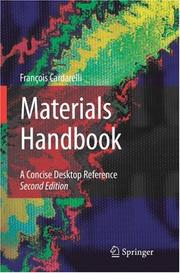| Listing 1 - 7 of 7 |
Sort by
|
Book
ISBN: 3319389238 3319389254 Year: 2018 Publisher: Cham : Springer International Publishing : Imprint: Springer,
Abstract | Keywords | Export | Availability | Bookmark
 Loading...
Loading...Choose an application
- Reference Manager
- EndNote
- RefWorks (Direct export to RefWorks)
The unique and practical Materials Handbook (third edition) provides quick and easy access to the physical and chemical properties of very many classes of materials. Its coverage has been expanded to include whole new families of materials such as minor metals, ferroalloys, nuclear materials, food, natural oils, fats, resins, and waxes. Many of the existing families—notably the metals, gases, liquids, minerals, rocks, soils, polymers, and fuels—are broadened and refined with new material and up-to-date information. Several of the larger tables of data are expanded and new ones added. Particular emphasis is placed on the properties of common industrial materials in each class. After a chapter introducing some general properties of materials, each of twenty classes of materials receives attention in its own chapter. The health and safety issues connected with the useand handling of industrial materials are included. Detailed appendices provide additional information on subjects as diverse as crystallography, spectroscopy, thermochemical data, analytical chemistry, corrosion resistance, and economic data for industrial and hazardous materials. Specific further reading sections and a general bibliography round out this comprehensive guide. The index and tabular format of the book makes light work of extracting what the reader needs to know from the wealth of factual information within these covers. Dr. François Cardarelli has spent many years compiling and editing materials data. His professional expertise and experience combine to make this handbook an indispensable reference tool for scientists and engineers working in numerous fields ranging from chemical to nuclear engineering. Particular emphasis is placed on the properties of common industrial materials in each class. After a chapter introducing some general properties of materials, materials are classified as follows. ferrous metals and their alloys; ferroalloys; common nonferrous metals; less common metals; minor metals; semiconductors and superconductors; magnetic materials; insulators and dielectrics; miscellaneous electrical materials; ceramics, refractories and glasses; polymers and elastomers; minerals, ores and gemstones; rocks and meteorites; soils and fertilizers; construction materials; timbers and woods; fuels, propellants and explosives; composite materials; gases; liquids; food, oils, resin and waxes; nuclear materials. food materials.
Materials --- Materials. --- Chemistry, inorganic. --- Chemical engineering. --- Materials Science, general. --- Materials Engineering. --- Inorganic Chemistry. --- Industrial Chemistry/Chemical Engineering. --- Inorganic chemistry --- Chemistry --- Inorganic compounds --- Engineering --- Engineering materials --- Industrial materials --- Engineering design --- Manufacturing processes --- Chemistry, Industrial --- Engineering, Chemical --- Industrial chemistry --- Chemistry, Technical --- Metallurgy --- Materials science. --- Engineering—Materials. --- Inorganic chemistry. --- Material science --- Physical sciences
Digital
ISBN: 9781846286698 Year: 2008 Publisher: London Springer-Verlag
Abstract | Keywords | Export | Availability | Bookmark
 Loading...
Loading...Choose an application
- Reference Manager
- EndNote
- RefWorks (Direct export to RefWorks)
Nuclear physics --- Metals and their compounds --- Materials sciences --- Engineering sciences. Technology --- Civil engineering. Building industry --- materiaalkennis --- deeltjesfysica --- kernenergie --- ingenieurswetenschappen --- metalen
Digital
ISBN: 9783319389257 Year: 2018 Publisher: Cham Springer International Publishing
Abstract | Keywords | Export | Availability | Bookmark
 Loading...
Loading...Choose an application
- Reference Manager
- EndNote
- RefWorks (Direct export to RefWorks)
The unique and practical Materials Handbook (third edition) provides quick and easy access to the physical and chemical properties of very many classes of materials. Its coverage has been expanded to include whole new families of materials such as minor metals, ferroalloys, nuclear materials, food, natural oils, fats, resins, and waxes. Many of the existing families—notably the metals, gases, liquids, minerals, rocks, soils, polymers, and fuels—are broadened and refined with new material and up-to-date information. Several of the larger tables of data are expanded and new ones added. Particular emphasis is placed on the properties of common industrial materials in each class. After a chapter introducing some general properties of materials, each of twenty classes of materials receives attention in its own chapter. The health and safety issues connected with the useand handling of industrial materials are included. Detailed appendices provide additional information on subjects as diverse as crystallography, spectroscopy, thermochemical data, analytical chemistry, corrosion resistance, and economic data for industrial and hazardous materials. Specific further reading sections and a general bibliography round out this comprehensive guide. The index and tabular format of the book makes light work of extracting what the reader needs to know from the wealth of factual information within these covers. Dr. François Cardarelli has spent many years compiling and editing materials data. His professional expertise and experience combine to make this handbook an indispensable reference tool for scientists and engineers working in numerous fields ranging from chemical to nuclear engineering. Particular emphasis is placed on the properties of common industrial materials in each class. After a chapter introducing some general properties of materials, materials are classified as follows. ferrous metals and their alloys; ferroalloys; common nonferrous metals; less common metals; minor metals; semiconductors and superconductors; magnetic materials; insulators and dielectrics; miscellaneous electrical materials; ceramics, refractories and glasses; polymers and elastomers; minerals, ores and gemstones; rocks and meteorites; soils and fertilizers; construction materials; timbers and woods; fuels, propellants and explosives; composite materials; gases; liquids; food, oils, resin and waxes; nuclear materials. food materials.
Inorganic chemistry --- Materials sciences --- Applied physical engineering --- Engineering sciences. Technology --- Chemical technology --- composieten --- legeringen --- materiaalkennis --- elastomeren --- BIT (biochemische ingenieurstechnieken) --- anorganische chemie --- ingenieurswetenschappen --- chemische technologie --- polymeren

ISBN: 185233682X 9781852336820 Year: 2003 Publisher: London: Springer,
Abstract | Keywords | Export | Availability | Bookmark
 Loading...
Loading...Choose an application
- Reference Manager
- EndNote
- RefWorks (Direct export to RefWorks)
Metric system --- Units of measurement --- Conversion tables --- 389 --- Metrologie --- Reference Works. Other Reference Works --- Other Reference Works (General) --- Units and Measures --- Units and Measures. --- 389 Metrologie --- International metric system --- International system of units --- SI (Weights and measures) --- SI-metric --- Weights and measures --- Metric system - Conversion tables - Handbooks, manuals, etc. --- Units of measurement - Handbooks, manuals, etc.

ISBN: 3540760229 1447133943 9783540760221 Year: 1997 Publisher: Berlin: Springer,
Abstract | Keywords | Export | Availability | Bookmark
 Loading...
Loading...Choose an application
- Reference Manager
- EndNote
- RefWorks (Direct export to RefWorks)
1.2 How to Use This Book Chapter 2 contains a brief history of the metric system, including the organization and a complete description of SI Units (Systeme International d'Unites). Chapter 3 gives a detailed description of a considerable number of other systems of measurement. This includes several alternative modern systems of measurement, some of which are still in widespread use (e.g. imperial, US, cgs, MTS, FPS). Finally, there is a description of systems used in antiquity (e.g. ancient Chinese, Indian, Egyptian, Persian, Hebrew, Greek, Roman, Arabic), as well as older national or regional systems (e.g. French, Italian, German, Japanese). Chapter 4, which forms the most important part of the book, consists of an exhaustive set of conversion tables. This chapter covers the units in alphabe tical order. Each unit is fully described as follows: name, symbol(s), physical quantity, dimension, conversion factor, notes and definitions. The section covers some 2000 units, each with a precise conversion factor. Chapter 5 enables a unit to be identified from its area of application. For this purpose, units are classed in groups. It contains thirty five conversion tables ranging from mass to nuclear quantities. In order to facilitate use of this manual, several supplementary sections have been added to aid the researcher. These include tables of fundamental math ematical and physical constants to allow very precise calculation of conver sions. These form the sixth chapter of the book.
Measuring methods in physics --- Metric system --- Units of measurement --- Physical Sciences & Mathematics --- Weights & Measures --- Physics --- Chemical engineering. --- Electrical engineering. --- Civil engineering. --- Chemistry. --- Physics. --- Medicine. --- Industrial Chemistry/Chemical Engineering. --- Electrical Engineering. --- Civil Engineering. --- Chemistry/Food Science, general. --- Physics, general. --- Medicine/Public Health, general. --- Health Workforce --- Natural philosophy --- Philosophy, Natural --- Physical sciences --- Dynamics --- Engineering --- Public works --- Electric engineering --- Chemistry, Industrial --- Engineering, Chemical --- Industrial chemistry --- Chemistry, Technical --- Metallurgy --- Metric system. --- International metric system --- International system of units --- SI (Weights and measures) --- SI-metric --- Weights and measures --- Metric system - Conversion tables - Handbooks, manuals, etc. --- Units of measurement - Conversion tables - Handbooks, manuals, etc. --- Systeme international d'unite --- Unite de mesure --- Constante

ISBN: 9781846286681 9781846286698 Year: 2008 Publisher: London Springer London
Abstract | Keywords | Export | Availability | Bookmark
 Loading...
Loading...Choose an application
- Reference Manager
- EndNote
- RefWorks (Direct export to RefWorks)
From the reviews of the second edition: The unique and practical Materials Handbook (second edition) provides quick and easy access to data on the physical and chemical properties of all classes of materials. The second edition has been much expanded to include whole new families of materials while many of the existing families are broadened and refined with new material and up-to-date information. Particular emphasis is placed on the properties of common industrial materials in each class. After a chapter introducing some general properties of materials, materials are classified as follows: ¢ ferrous metals and their alloys; ¢ nonferrous metals; ¢ semiconductors and superconductors; ¢ magnetic materials; ¢ insulators and dielectrics; ¢ miscellaneous electrical materials; ¢ ceramics, refractories and glasses; ¢ polymers and elastomers; ¢ minerals, ores and gemstones; ¢ rocks and meteorites; ¢ soils and fertilizers; ¢ cements, concrete, building stones and construction materials; ¢ timbers and woods; ¢ fuels, propellants and explosives; ¢ composite materials; ¢ gases; ¢ liquids. Detailed appendices provide additional information on subjects as diverse as crystallography, natural radioactivity and economic data for industrial materials. Specific further reading sections and a general bibliography round out this comprehensive guide. The index and tabular format of the book make light work of extracting what the reader needs to know from the wealth of factual information within these covers. François Cardarelli has spent many years compiling and editing materials data. His professional expertise and experience combine to make this handbook an indispensable reference tool for scientists and engineers working in fields from mechanical, electrical, and chemical to metallurgical and nuclear engineering. "This volume covers metals and alloys, nonferrous metals, semiconductors, ceramics, polymers, earth materials, concrete, wood, fuels, composites, gases, and liquids. ¦ many industrial and university libraries will find it a useful one-volume reference. Summing Up: Recommended. Upper-level undergraduates through professionals/practitioners." (A. M. Strauss, Choice, Vol. 46 (2), October, 2008)
Book
Abstract | Keywords | Export | Availability | Bookmark
 Loading...
Loading...Choose an application
- Reference Manager
- EndNote
- RefWorks (Direct export to RefWorks)
| Listing 1 - 7 of 7 |
Sort by
|

 Search
Search Feedback
Feedback About UniCat
About UniCat  Help
Help News
News